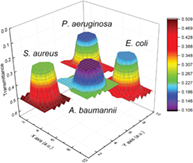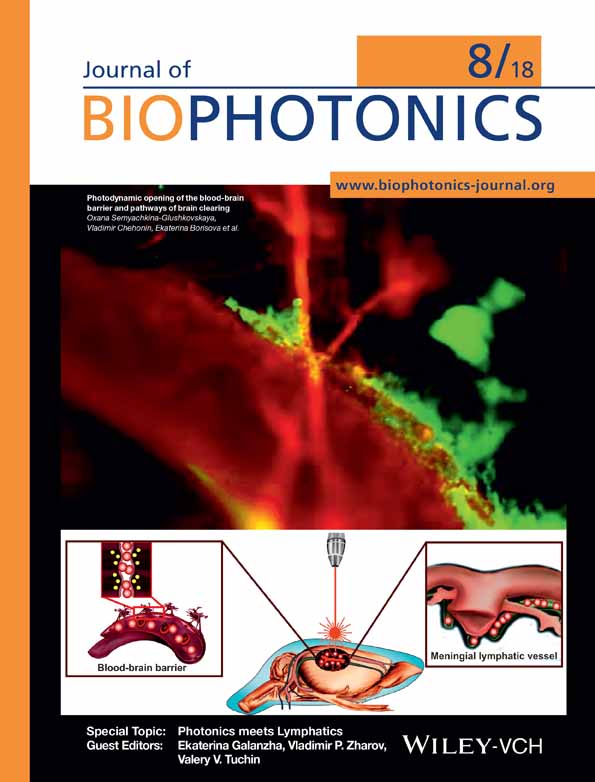Label-free bacterial colony detection and viability assessment by continuous-wave terahertz transmission imaging
Xiang Yang
Department of Laboratory Medicine, Southwest Hospital, Third Military Medical University (Army Medical University), Chongqing, China
Search for more papers by this authorJia Shi
Institute of Laser and Optoelectronics, School of Precision Instrument and Optoelectronic Engineering, Tianjin University, Tianjin, China
Key Laboratory of Optoelectronic Information Science and Technology (Ministry of Education), Tianjin University, Tianjin, China
Search for more papers by this authorCorresponding Author
Yuye Wang
Institute of Laser and Optoelectronics, School of Precision Instrument and Optoelectronic Engineering, Tianjin University, Tianjin, China
Key Laboratory of Optoelectronic Information Science and Technology (Ministry of Education), Tianjin University, Tianjin, China
Correspondence
Yuye Wang, Institute of Laser and Optoelectronics, School of Precision Instrument and Optoelectronic Engineering, Tianjin University, Tianjin 300072, China.
Email: [email protected]
Weiling Fu, Department of Laboratory Medicine, Southwest Hospital, Third Military Medical University (Army Medical University), Chongqing 400038, China.
Email: [email protected]
Search for more papers by this authorKe Yang
Department of Laboratory Medicine, Southwest Hospital, Third Military Medical University (Army Medical University), Chongqing, China
Search for more papers by this authorXiang Zhao
Department of Laboratory Medicine, Southwest Hospital, Third Military Medical University (Army Medical University), Chongqing, China
Search for more papers by this authorGuiyu Wang
Department of Laboratory Medicine, Southwest Hospital, Third Military Medical University (Army Medical University), Chongqing, China
Search for more papers by this authorDegang Xu
Institute of Laser and Optoelectronics, School of Precision Instrument and Optoelectronic Engineering, Tianjin University, Tianjin, China
Key Laboratory of Optoelectronic Information Science and Technology (Ministry of Education), Tianjin University, Tianjin, China
Search for more papers by this authorYunxia Wang
Department of Laboratory Medicine, Southwest Hospital, Third Military Medical University (Army Medical University), Chongqing, China
Search for more papers by this authorJianquan Yao
Institute of Laser and Optoelectronics, School of Precision Instrument and Optoelectronic Engineering, Tianjin University, Tianjin, China
Key Laboratory of Optoelectronic Information Science and Technology (Ministry of Education), Tianjin University, Tianjin, China
Search for more papers by this authorCorresponding Author
Weiling Fu
Department of Laboratory Medicine, Southwest Hospital, Third Military Medical University (Army Medical University), Chongqing, China
Correspondence
Yuye Wang, Institute of Laser and Optoelectronics, School of Precision Instrument and Optoelectronic Engineering, Tianjin University, Tianjin 300072, China.
Email: [email protected]
Weiling Fu, Department of Laboratory Medicine, Southwest Hospital, Third Military Medical University (Army Medical University), Chongqing 400038, China.
Email: [email protected]
Search for more papers by this authorXiang Yang
Department of Laboratory Medicine, Southwest Hospital, Third Military Medical University (Army Medical University), Chongqing, China
Search for more papers by this authorJia Shi
Institute of Laser and Optoelectronics, School of Precision Instrument and Optoelectronic Engineering, Tianjin University, Tianjin, China
Key Laboratory of Optoelectronic Information Science and Technology (Ministry of Education), Tianjin University, Tianjin, China
Search for more papers by this authorCorresponding Author
Yuye Wang
Institute of Laser and Optoelectronics, School of Precision Instrument and Optoelectronic Engineering, Tianjin University, Tianjin, China
Key Laboratory of Optoelectronic Information Science and Technology (Ministry of Education), Tianjin University, Tianjin, China
Correspondence
Yuye Wang, Institute of Laser and Optoelectronics, School of Precision Instrument and Optoelectronic Engineering, Tianjin University, Tianjin 300072, China.
Email: [email protected]
Weiling Fu, Department of Laboratory Medicine, Southwest Hospital, Third Military Medical University (Army Medical University), Chongqing 400038, China.
Email: [email protected]
Search for more papers by this authorKe Yang
Department of Laboratory Medicine, Southwest Hospital, Third Military Medical University (Army Medical University), Chongqing, China
Search for more papers by this authorXiang Zhao
Department of Laboratory Medicine, Southwest Hospital, Third Military Medical University (Army Medical University), Chongqing, China
Search for more papers by this authorGuiyu Wang
Department of Laboratory Medicine, Southwest Hospital, Third Military Medical University (Army Medical University), Chongqing, China
Search for more papers by this authorDegang Xu
Institute of Laser and Optoelectronics, School of Precision Instrument and Optoelectronic Engineering, Tianjin University, Tianjin, China
Key Laboratory of Optoelectronic Information Science and Technology (Ministry of Education), Tianjin University, Tianjin, China
Search for more papers by this authorYunxia Wang
Department of Laboratory Medicine, Southwest Hospital, Third Military Medical University (Army Medical University), Chongqing, China
Search for more papers by this authorJianquan Yao
Institute of Laser and Optoelectronics, School of Precision Instrument and Optoelectronic Engineering, Tianjin University, Tianjin, China
Key Laboratory of Optoelectronic Information Science and Technology (Ministry of Education), Tianjin University, Tianjin, China
Search for more papers by this authorCorresponding Author
Weiling Fu
Department of Laboratory Medicine, Southwest Hospital, Third Military Medical University (Army Medical University), Chongqing, China
Correspondence
Yuye Wang, Institute of Laser and Optoelectronics, School of Precision Instrument and Optoelectronic Engineering, Tianjin University, Tianjin 300072, China.
Email: [email protected]
Weiling Fu, Department of Laboratory Medicine, Southwest Hospital, Third Military Medical University (Army Medical University), Chongqing 400038, China.
Email: [email protected]
Search for more papers by this authorAbstract
Timely and accurate bacterial detection is critical for various health and safety applications, which promotes the continuous development of versatile optical sensors for bacterial investigations. Here, we report a new strategy for bacterial colony sensing using terahertz (THz) imaging with minimal assay procedures. The proposed method utilizes the acute sensitivity of THz wave to the changes in the water content and cellular structures. Single bacterial colonies of 4 bacterial species were directly distinguished using THz imaging by utilizing their differences in THz absorption. In addition, the distribution of mixed bacterial samples has been demonstrated by THz imaging, which demonstrated that the target bacterium could be easily recognized. Furthermore, we investigated the differentiation of bacterial viability, which indicated that bacteria under different living states could be distinguished by THz imaging because of their different hydration levels and cellular structures. Our results suggest that THz imaging has the potential to be used for mixed bacterial sample detection and bacterial viability assessment in a label-free and nondestructive manner.

REFERENCES
- 1B. W. Buchan, N. A. Ledeboer, Clin. Microbiol. Rev. 2014, 27, 783.
- 2A. Nocker, C.-Y. Cheung, A. K. Camper, J. Microbiol. Methods. 2006, 67, 310.
- 3P. P. Banada, K. Huff, E. Bae, B. Rajwa, A. Aroonnual, B. Bayraktar, A. Adil, J. P. Robinson, E. D. Hirleman, A. K. Bhunia, Biosens Bioelectron. 2009, 24, 1685.
- 4E. Pickwell, V. P. Wallace, J. Phys. D Appl. Phys. 2006, 39, R301.
- 5J.-H. Son, Nanotechnology 2013, 24, 214001.
- 6G. J. Wilmink, B. L. Ibey, T. Thomas, S. Brian, L. Norman, X. G. Peralta, C. C. Roth, C. Z. Cerna, B. D. Rivest, J. E. Grundt, J. Biomed. Opt. 2011, 16, 047006.
- 7P. Tewari, C. P. Kealey, D. B. Bennett, N. Bajwa, K. S. Barnett, R. S. Singh, M. O. Culjat, A. Stojadinovic, W. S. Grundfest, Z. D. Taylor, J. Biomed. Opt. 2012, 17, 040503.
- 8H.-B. Liu, G. Plopper, S. Earley, Y. Chen, B. Ferguson, X. C. Zhang, Biosens Bioelectron. 2007, 22, 1075.
- 9B. Born, S. J. Kim, S. Ebbinghaus, M. Gruebele, M. Havenith, Faraday Discuss. 2009, 141, 161.
- 10M. I. Lvovska, N. C. Seeman, R. Sha, T. R. Globus, T. B. Khromova, T. S. Dorofeeva, IEEE Trans. Nanotechnol. 2010, 9, 610.
- 11M. Grognot, G. Gallot, Appl. Phys. Lett. 2015, 107, 103702.
- 12S. J. Oh, S.-H. Kim, Y. B. Ji, K. Jeong, Y. Park, J. Yang, D. W. Park, S. K. Noh, S.-G. Kang, Y.-M. Huh, J.-H. Son, J.-S. Suh, Biomed. Opt. Express 2014, 5, 2837.
- 13X. Yang, K. Yang, Y. Luo, W. Fu, Appl. Microbiol. Biotechnol. 2016, 100, 5289.
- 14E. R. Brown, T. B. Khromova, T. Globus, D. L. Woolard, J. O. Jensen, A. Majewski, IEEE Sensors J. 2006, 6, 1076.
- 15W. Zhang, E. R. Brown, L. Viveros, K. P. Burris, C. N. Stewart Jr.., J. Biophotonics. 2014, 7, 818.
- 16E. R. Brown, J. E. Bjarnason, T. L. J. Chan, A. W. M. Lee, M. A. Celis, Appl. Phys. Lett. 2004, 84, 3438.
- 17X. Yang, D. Wei, S. Yan, Y. Liu, S. Yu, M. Zhang, Z. Yang, X. Zhu, Q. Huang, H.-L. Cui, W. Fu, J. Biophotonics. 2016, 9, 1050.
- 18T. Globus, A. M. Moyer, B. Gelmont, T. Khromova, M. I. Lvovska, I. Sizov, J. Ferrance, IEEE Sensors J. 2013, 13, 72.
- 19T. Globus, T. Dorofeeva, I. Sizov, B. Gelmont, M. Lvovska, T. Khromova, O. Chertihin, Y. Koryakina, Am. J. Biomed. Eng. 2012, 2, 143.
10.5923/j.ajbe.20120204.01 Google Scholar
- 20K. Wang, D.-W. Sun, H. Pu, Trends Food Sci. Technol. 2017, 67, 93.
- 21E. O. King, M. K. Ward, D. E. Raney, J. Lab. Clin. Med. 1954, 44, 301.
- 22Y. Persson, A.-K. J. Nyman, U. Gronlund-Andersson, Acta Vet. Scand. 2011, 53, 36.
- 23X. Yang, X. Zhao, K. Yang, Y. Liu, Y. Liu, W. Fu, Y. Luo, Trends Biotechnol. 2016, 34, 810.
- 24K. Shiraga, T. Suzuki, N. Kondo, K. Tanaka, Y. Ogawa, Appl. Phys. Lett. 2015, 106, 253701.
- 25R. Cooke, I. D. Kuntz, Ann. Rev. Biophys. Bioeng. 1974, 3, 95.
- 26K. Shiraga, Y. Ogawa, T. Suzuki, N. Kondo, A. Irisawa, M. Imamura, J. Infrared Millim. Te. 2014, 35, 493.
- 27C. Wang, J. Gong, Q. Xing, Y. Li, F. Liu, X. Zhao, L. Chai, C. Wang, A. M. Zheltikov, J. Biophotonics 2010, 3, 641.
- 28A. Berrier, M. C. Schaafsma, G. Nonglaton, J. Bergquist, J. G. Rivas, Biomed. Opt. Express 2012, 3, 2937.
- 29S. M. Yoo, S. Y. Lee, Trends Biotechnol. 2016, 34, 7.
- 30A. E. Clark, E. J. Kaleta, A. Arora, D. M. Wolk, Clin. Microbiol. Rev. 2013, 26, 547.
- 31A. M. Caliendo, D. N. Gilbert, C. C. Ginocchio, K. E. Hanson, L. May, T. C. Quinn, F. C. Tenover, D. Alland, A. J. Blaschke, R. A. Bonomo, K. C. Carroll, M. J. Ferraro, L. R. Hirschhorn, W. P. Joseph, T. Karchmer, A. T. MacIntyre, L. B. Reller, A. F. Jackson, Clin. Infect. Dis. 2013, 57, S139.
- 32P. P. Banada, S. Guo, B. Bayraktar, E. Bae, B. Rajwa, J. P. Robinson, E. D. Hirleman, A. K. Bhunia, Biosens Bioelectron. 2007, 22, 1664.
- 33A. Maestrini, B. Thomas, H. Wang, C. Jung, J. Treuttel, Y. Jin, G. Chattopadhyay, I. Mehdi, G. Beaudin, C. R. Phys. 2010, 11, 480.
- 34K. Kim, D. G. Lee, W. G. Ham, J. Ku, S. H. Lee, C. B. Ahn, J. H. Son, H. Park, IEEE Trans. THz Sci. Technol. 2013, 3, 395.




